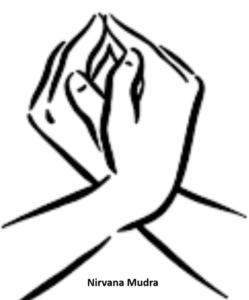Nirvana Mudra
Introduction
Nirvana Mudra is an advanced yogic mudra that symbolizes the dissolution of the ego and liberation of the self. The word Nirvana means “final liberation” or “freedom from bondage.” This mudra is practiced as part of higher meditative states and pranayama techniques to assist in the withdrawal of the senses, calming of the mind, and transcendence beyond duality.
It is often mentioned in Hatha Yoga and Tantra traditions as a hand gesture and sometimes as a combined meditative practice to deepen the practitioner’s state of samadhi.
Meaning
Nirvana = liberation, moksha, final freedom.
Mudra = seal, gesture, psychic lock.
Thus, Nirvana Mudra is the gesture that “seals the mind into liberation,” guiding the practitioner inward beyond sensory distractions.
How to Perform Practice
Step-by-Step
Sit in a meditative posture (Padmasana, Siddhasana, Vajrasana, or Sukhasana).
Keep the spine erect and shoulders relaxed.Stretch your arms in front of you, cross your wrists and bring your palms together.
Rotate your joined hands first down, then in toward your body and up, so all your fingers point upward.
Your palms will bow out slightly, but try to keep each fingertip pressing against its opposite finger.
Keep your thumbs side by side and elbows as close together as possible.
Bow your head slightly so your fingertips come closer to your brow chakra. Hold for 10–60 seconds or longer.
Release your hands, shake out and repeat with wrists crossed the opposite way.
This mudra is often practiced during dhyana (meditation), yoga nidra, or advanced pranayama sessions.
Benefits
Physical Benefits
Deeply relaxes the nervous system.
Reduces stress and psychosomatic tension.
Improves oxygenation through calm breathing.
Mental & Emotional Benefits
Promotes inner peace, detachment, and clarity.
Helps dissolve anxiety, restlessness, and overthinking.
Induces pratyahara (sense withdrawal).
Spiritual Benefits
Enhances meditation and prepares for samadhi.
Dissolves ego-identification.
Awakens Ajna Chakra and supports transcendental states.
Encourages realization of the Self beyond the body and mind.
Contraindications
Avoid if suffering from severe depression or dissociation, as it may intensify detachment.
Not recommended for beginners without guidance.
People with severe fatigue, low vitality, or hypotension should practice gently.
Anatomy & Physiology
Involves gentle hand and finger positioning that stimulates peripheral nerves.
Activates the parasympathetic nervous system, promoting relaxation.
Encourages slower heart rate and balanced breathing rhythms.
May influence pineal and pituitary gland activity when combined with deep meditation.
Kinesiology
Index finger crossing engages extensor and flexor muscles of the hand.
Gentle pressure between thumbs maintains a neuromuscular loop of awareness.
Postural alignment supports respiratory efficiency and spinal stability.
Neurology
Stimulates prefrontal cortex (awareness, concentration).
Calms the limbic system (emotional regulation).
Encourages hemispheric balance (left–right brain integration).
Activates vagus nerve → deeper relaxation response.
Duration of Mudra
Beginners: 5–10 minutes during meditation.
Intermediate: 15–30 minutes daily.
Advanced: Can be sustained for the entire meditation or yoga nidra session (45–60 minutes).
Counter Mudra
Chin Mudra / Jnana Mudra → grounding and wisdom gesture.
Hridaya Mudra → for emotional balance after deep detachment.
Prana Mudra → to restore energy flow post practice.
Conclusion
Nirvana Mudra is a powerful meditative hand gesture that leads the practitioner inward, helping dissolve the ego and achieve states of liberation. Unlike energizing mudras, Nirvana Mudra is introverting, assisting in deep meditation, pratyahara, and samadhi. It should be practiced with guidance, patience, and regularity, as it represents the yogic path of release from worldly attachments into inner freedom.
FAQ
Q1: Can beginners practice Nirvana Mudra?
Yes, but it is best practiced under guidance, as it is primarily a meditative mudra for advanced practitioners.
Q2: How is Nirvana Mudra different from Jnana Mudra?
Jnana Mudra stimulates wisdom and clarity, while Nirvana Mudra promotes detachment and transcendence.
Q3: Can it be practiced during pranayama?
Yes, it can enhance meditative pranayama by deepening focus.
Q4: Does Nirvana Mudra awaken chakras?
Yes, particularly the Ajna and Sahasrara chakras, facilitating higher awareness.
Q5: What is the best time to practice?
Early morning (Brahma Muhurta) or evening, in silence and meditation.
References
Swami Satyananda Saraswati – Asana, Pranayama, Mudra, Bandha
B.K.S. Iyengar – Light on Yoga
Indu Arora – Mudra: The Sacred Secret
Bihar School of Yoga Publications – Yoga Darshan
Swami Muktibodhananda – Hatha Yoga Pradipika Commentary

